Southern California is an area famous for its beautiful birds that attract birdwatchers from all over the world. The diverse terrain and climate in this region create an ideal habitat for a wide range of bird species, making it a birdwatching enthusiast’s paradise.
From the majestic bald eagles and red-tailed hawks to the colorful and tiny hummingbirds and finches, Southern California boasts some of the most extraordinary species of birds in the world.
These birds have become an essential part of the region’s culture and tourism industry, with birdwatchers flocking to the area to catch a glimpse of these fascinating avians.
With its mild climate and diverse geography, Southern California is home to an array of birds that will excite and captivate anyone with a love for nature and the avian world.
1. American Robin

The American robin is a migratory bird, belonging to the true thrush genus and Turdidae family.
It was named after its European counterpart due to the similar reddish-orange breast they both possess; however, they are not related closely.
This species can be seen through most of North America during winter months, as well as in parts of Mexico and Central America where it also breeds.
They have plump bodies with gray upperparts and white underparts that vary from yellow on their throats down to orange toward their bellies.
Robins feed on fruits such as berries or insects like worms which makes them an important part of ecosystems by helping disperse seeds naturally throughout these areas.
Scientific classification:
| Kingdom | Animalia |
| Phylum | Chordata |
| Class | Aves |
| Order | Passeriformes |
| Family | Turdidae |
| Genus | Turdus |
| Species | T. migratorius |
Also Featured In: Most Common United States Birds, Most Common Winter Birds
2. American Goldfinch
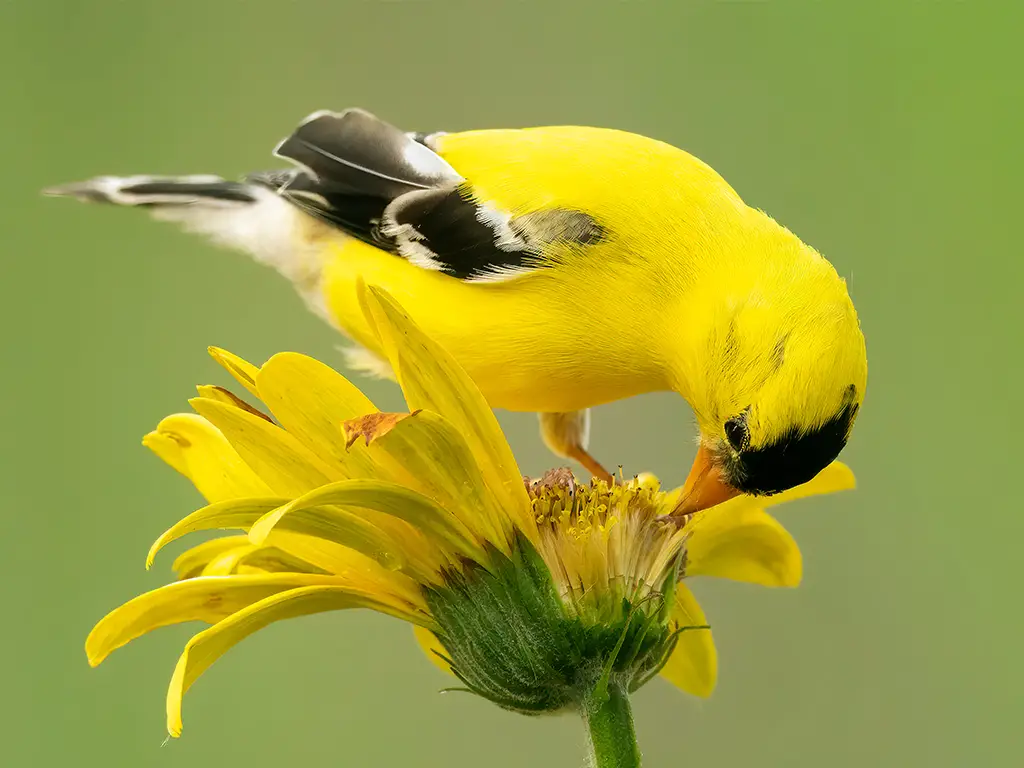
The American goldfinch is a small North American bird in the finch family. Males are vibrant yellow with black wings and tails, while females are duller in coloration.
It migrates from mid-Alberta to North Carolina during the breeding season, south of Canada–United States border to Mexico for its wintering grounds.
The only finch that undergoes complete molt every year, it displays sexual dichromatism where males have brighter colors than their female counterparts.
They feed mainly on seeds but also eat insects such as aphids and caterpillars when raising young; they often occur near thistles or other plants that produce viable seed heads.
Their call consists of an array of chirps and trills making them quite conspicuous.
Scientific classification:
| Kingdom | Animalia |
| Phylum | Chordata |
| Class | Aves |
| Order | Passeriformes |
| Family | Fringillidae |
| Subfamily | Carduelinae |
| Genus | Spinus |
| Species | S. tristis |
Also Featured In: Birds That Live in Colorado, Common Central Park Birds
3. Mourning Dove
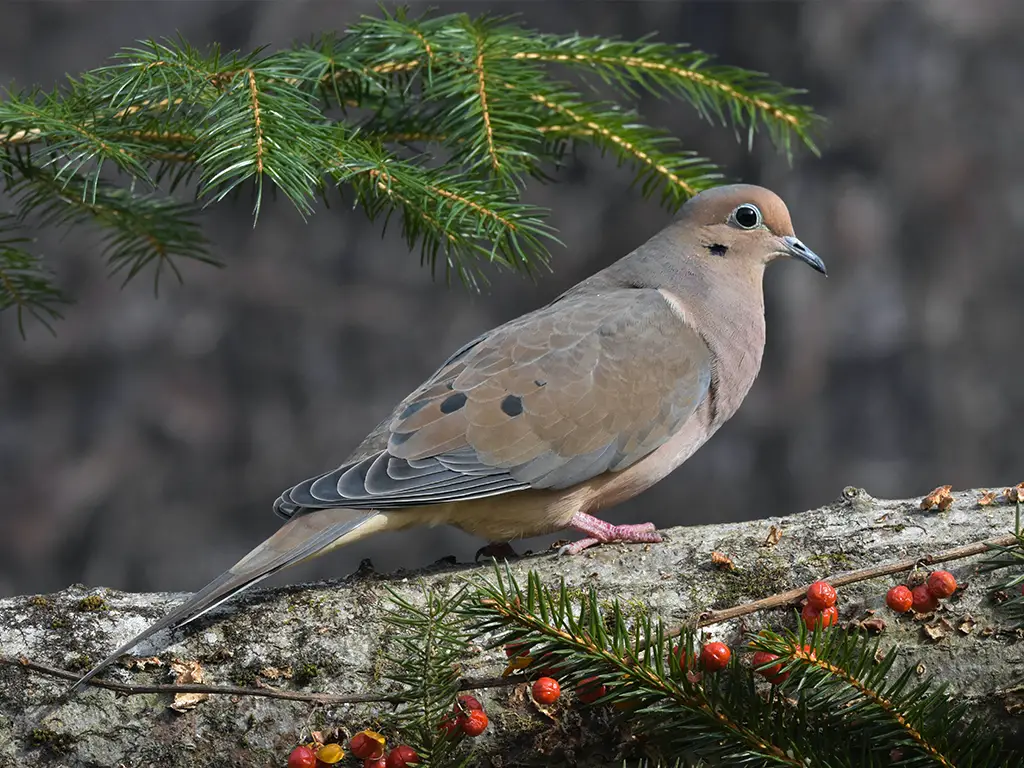
The Mourning Dove is a breathtakingly beautiful bird. It has stunning gray and brown feathers with white-tipped wings, giving it an elegant appearance. Its long tail also adds to its graceful look in flight.
A symbol of peace and serenity, they are abundant across North America and can be found in gardens or open fields throughout the year.
As well as being popular game birds for hunters, they feed on grains such as wheat and millet providing important food sources for wildlife species including foxes, coyotes, skunks, and raccoons.
These doves have a distinctive cooing sound that can often be heard echoing through woodlands during summer evenings making them one of nature’s greatest treasures.
Scientific classification:
| Kingdom | Animalia |
| Phylum | Chordata |
| Class | Aves |
| Order | Columbiformes |
| Family | Columbidae |
| Genus | Zenaida |
| Species | Z. macroura |
Also Featured In: Common Birds That Live in Las Vegas, Most Common Nature Birds
4. Anna’s Hummingbird
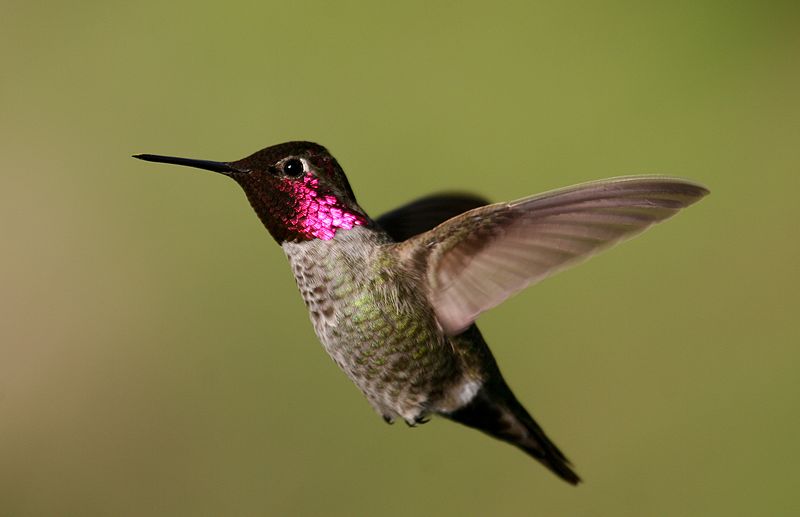
Anna’s hummingbird is a beautiful species of bird belonging to the Trochilidae family. Native to western coastal regions of North America, it was named after Anna Masséna, Duchess of Rivoli.
In the early 20th century, these birds bred only in northern Baja California and southern California but due to ornamental plant transplanting they can now be found across much of the Pacific Coast region.
They are medium-sized with bright emerald green feathers on their back and crowns as well as rose-red patches at the throat for males which makes them quite distinguishable from other birds.
Their diet consists mainly of nectar from flowers although they will occasionally feed on insects or spiders too making them important pollinators that help maintain healthy ecosystems.
Scientific classification:
| Kingdom | Animalia |
| Phylum | Chordata |
| Class | Aves |
| Order | Apodiformes |
| Family | Trochilidae |
| Genus | Calypte |
| Species | C. anna |
Also Featured In: Flight Birds You Should Know, British Columbian Birds
5. Allen’s Hummingbird
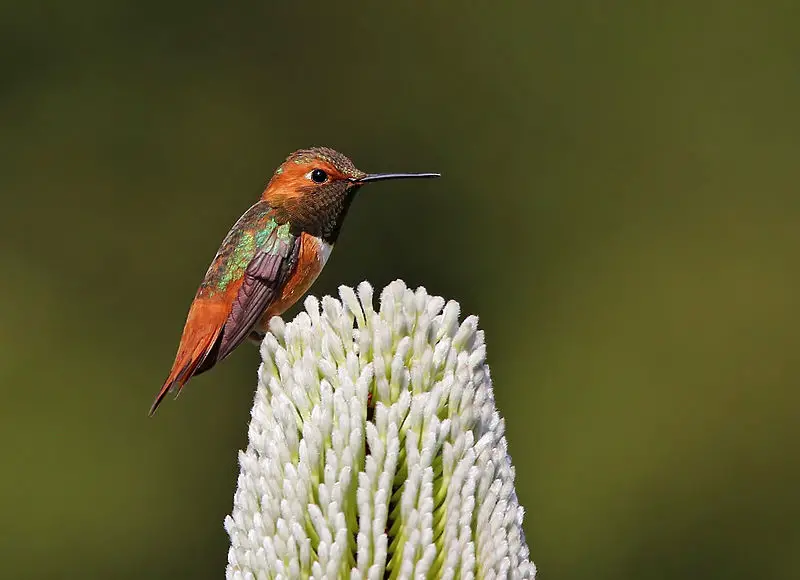
Allen’s Hummingbird is a beautiful species of hummingbird that breeds in the western United States. It stands only 3-3.5 inches long and its stunningly vibrant plumage makes it an incredible sight to behold.
The male has a green back and forehead, with rust-colored (rufous) flanks, rump, and tail while his throat dazzles with an iridescent orange coloration.
Females are similarly colored but lack the colorful throat patch of males.
These birds feed primarily on nectar from flowers such as sagebrush, California fuchsia or currant bushes using their long bills and tongues to extract food from deep within them.
They also eat small insects for protein which they capture in flight like other hummingbirds do.
Allen’s Hummingbird can be found near chaparral shrubland during breeding season when wildflowers abound giving these tiny beauties plenty of sustenance.Scientific classification:
| Kingdom | Animalia |
| Phylum | Chordata |
| Class | Aves |
| Order | Apodiformes |
| Family | Trochilidae |
| Genus | Selasphorus |
| Species | S. sasin |
Also Featured In: Orange County Birds You Need to See, Hummingbirds that Live in Ohio
6. Belted Kingfisher
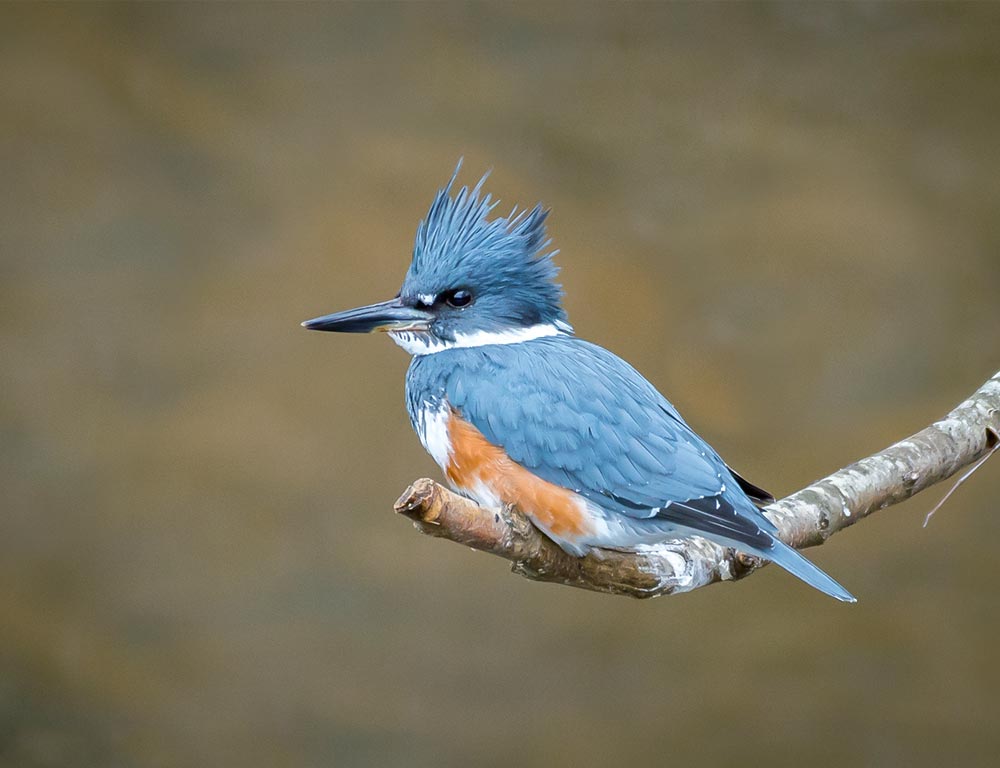
The belted kingfisher is a large, eye-catching bird native to North America. It belongs to the family Alcedinidae and has been divided into three subfamilies by recent research.
The species was first described in 1758 by Carl Linnaeus in his Systema Naturae.
This water Kingfisher stands out for its size as well as its striking plumage; males are bright blue on top with white below and females have rusty brown backs and wings with a thick black breast band across their chest.
They also possess an impressive call that can be heard from quite far away.
Belted kingfishers feed mainly on small fish but will sometimes also eat crustaceans, insects, or even amphibians if they come across them while hunting around rivers or streams.
All in all, this is truly one remarkable bird that deserves our admiration.
Scientific classification:
| Kingdom | Animalia |
| Phylum | Chordata |
| Class | Aves |
| Order | Coraciiformes |
| Family | Alcedinidae |
| Subfamily | Cerylinae |
| Genus | Megaceryle |
| Species | M. alcyon |
Also Featured In: Most Popular Bird Species in North America, Long Island Birds You Should Know
7. Black-Chinned Hummingbird
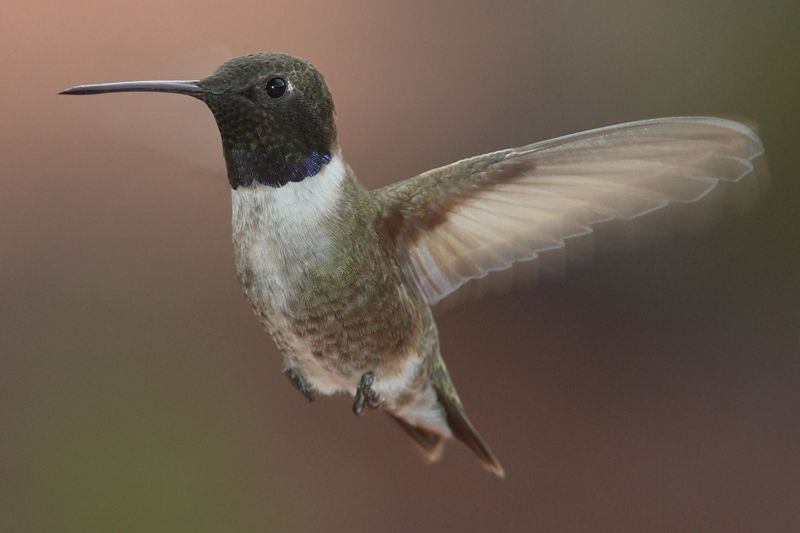
The Black-chinned Hummingbird (Archilochus alexandri) is a small but widely distributed bird. It migrates to Mexico for the winter months, and in summer can be found across much of North America.
The Black-chinned Hummingbird has been known to hybridize with several other species such as Anna’s, Lucifer, Broad-tailed, and Costa’s hummingbirds.
It prefers open habitats like desert scrub or grasslands that provide plenty of nectar from flowers.
These birds are also capable flyers, able to reach speeds of up to 34 miles per hour. With its dazzling plumage and impressive flying skills the Black-chinned Hummingbird makes an intriguing sight for any nature enthusiast lucky enough to spot one in the wild.
Scientific classification:
| Kingdom | Animalia |
| Phylum | Chordata |
| Class | Aves |
| Order | Apodiformes |
| Family | Trochilidae |
| Genus | Archilochus |
| Species | A. alexandri |
Also Featured In: Central Texas Birds, Small Birds of Texas
8. Great Horned Owl
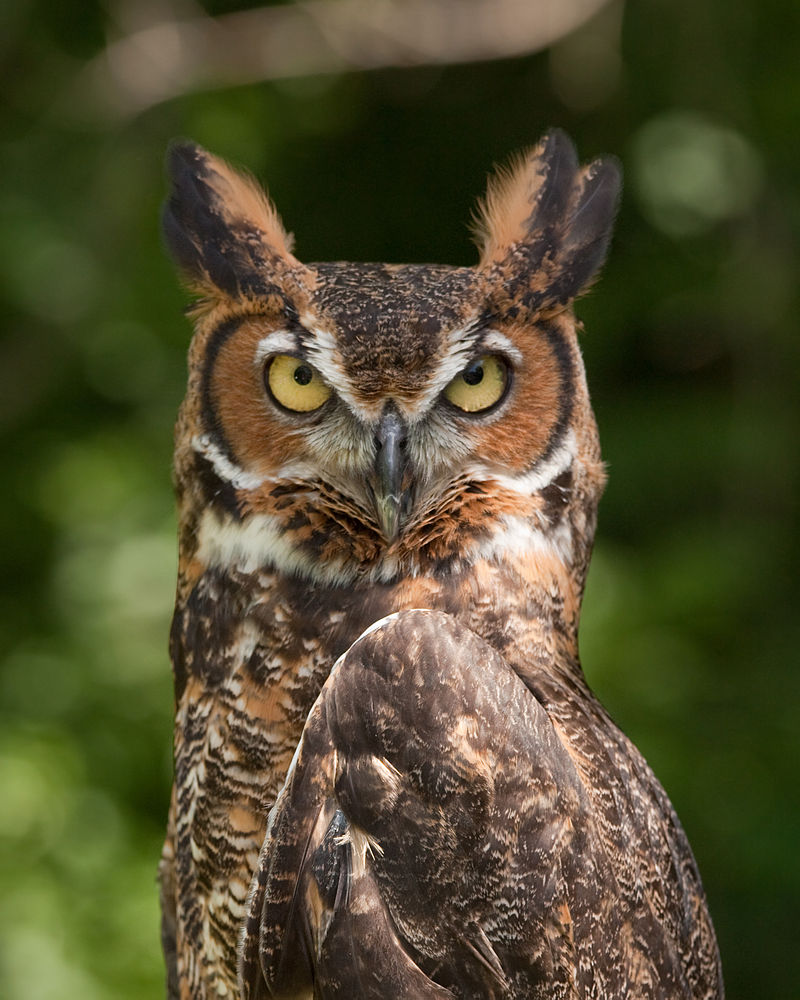
The Great Horned Owl is an impressive bird native to the Americas. It is well-known for its wide range and adaptability, as it can be found in many different habitats across the continent.
Its diet consists primarily of rabbits, hares, rats, and mice; however, they are also known to consume skunks, geese, and other birds too.
With their powerful talons capable of crushing prey with ease, these owls have earned themselves a fearsome reputation due to their incredible strength.
Their iconic horn-like tufts on either side of its head add another layer of intimidation which helps them stand out from other owls in the area.
Scientific classification:
| Kingdom | Animalia |
| Phylum | Chordata |
| Class | Aves |
| Order | Strigiformes |
| Family | Strigidae |
| Genus | Bubo |
| Species | B. virginianus |
Also Featured In: Birds You’ll Find in Zoo, Common Birds in Alberta
9. Burrowing Owl
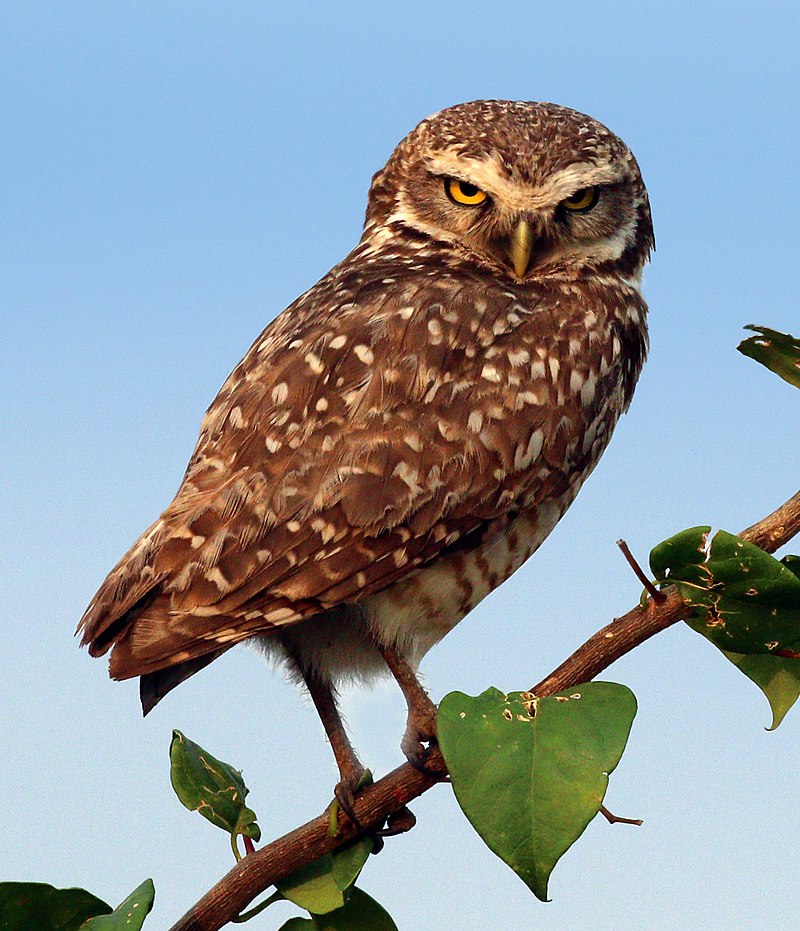
The Burrowing Owl is a small, long-legged owl found in open landscapes throughout North and South America. They are typically seen in grasslands, rangelands, agricultural areas or deserts with low vegetation.
Unlike most owls, they nest and roost underground by taking over burrows made by other animals such as prairie dogs.
Their diet consists of insects, rodents, and sometimes lizards or frogs that they hunt during the nighttime hours when their eyesight is sharpest.
This species faces threats due to habitat loss caused by human development but conservation efforts have been successful at reversing some of this damage allowing for populations to remain stable into the future despite these pressures.
Scientific classification:
| Kingdom | Animalia |
| Phylum | Chordata |
| Class | Aves |
| Order | Strigiformes |
| Family | Strigidae |
| Genus | Athene |
| Species | A. cunicularia |
Also Featured In: Beautiful Brazilian Birds, Birds that Live around Southwest Florida
10. Bewick’s Wren
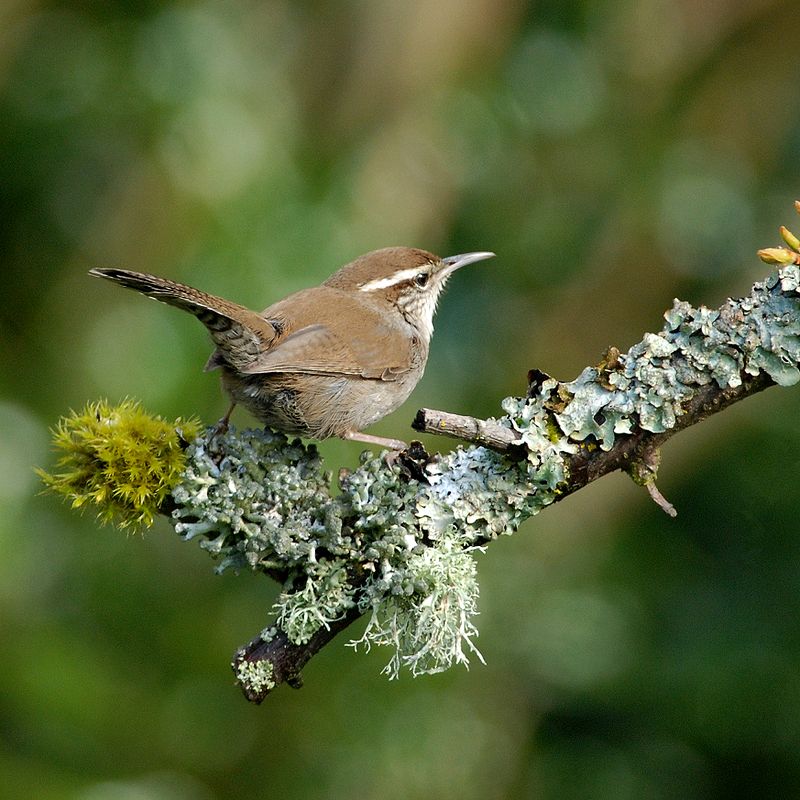
The Bewick’s wren (Thryomanes bewickii) is a small, grey-brown bird native to North America. Measuring around 14 cm long it has distinctive white markings on its face and tail giving it an attractive appearance.
It can often be found in thickets or scrubby areas as well as urban gardens and parks.
Its song is loud and melodious which makes them popular amongst ornithologists; they are known for its complex vocalizations composed of whistles, clicks, churrs and trills.
The Bewick’s Wren mainly feeds on insects but will also eat fruits if available during the colder months when food may otherwise be scarce.
This species of wren plays an important role in controlling insect populations making them beneficial inhabitants of our environment.
Scientific classification:
| Kingdom | Animalia |
| Phylum | Chordata |
| Class | Aves |
| Order | Passeriformes |
| Family | Troglodytidae |
| Genus | Thryomanes P.L. Sclater, 1862 |
| Species | T. bewickii |
Also Featured In: Top Birds Found in Mexico, Birds in Pacific Northwest
11. Green Heron
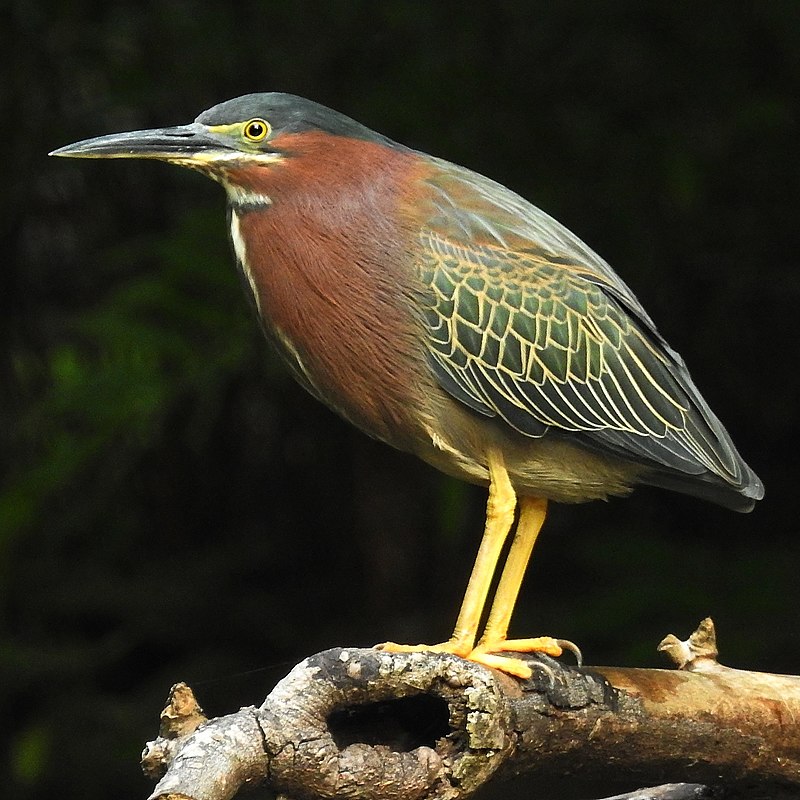
The Green Heron (Butorides virescens) is a small heron found throughout North and Central America.
Its scientific name comes from the Middle English ‘butor’ meaning bittern, combined with the Latin term for its distinctive greenish color – ‘virescens’.
For many years it was considered to be part of the same species as the Striated Heron (Butorides striata), commonly referred to as “green-backed herons”.
The nominate subspecies inhabits wetlands across much of this range, where they can be spotted stalking about in shallow water looking for fish or frogs on which to feed.
They are fascinating wading birds that have even been known to use tools such as sticks or baited lines when fishing.
Scientific classification:
| Kingdom | Animalia |
| Phylum | Chordata |
| Class | Aves |
| Order | Pelecaniformes |
| Family | Ardeidae |
| Genus | Butorides |
| Species | B. virescens |
Also Featured In: Birds that You’ll Find in Puerto Rico, Swamps Birds You Should Know
12. Cooper’s Hawk
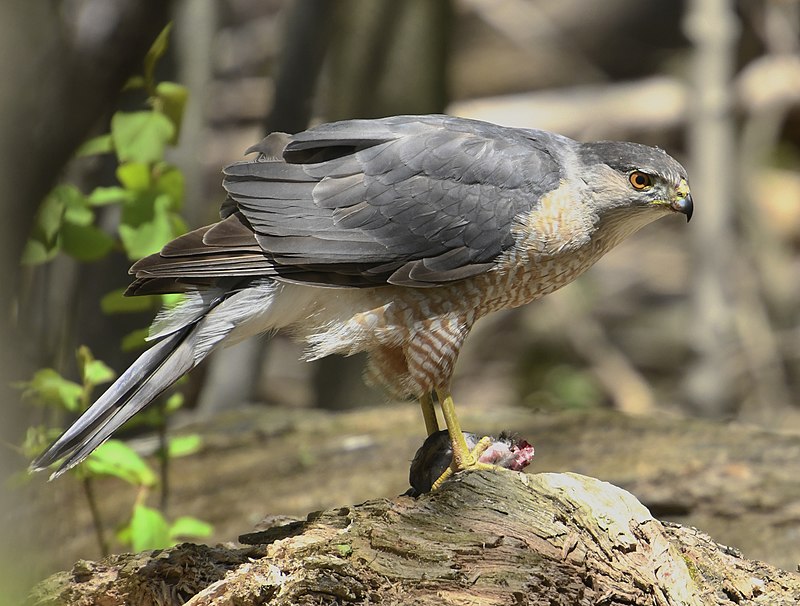
Cooper’s Hawk is a medium-sized bird of prey native to North America. It belongs to the Accipiter genus, which is known for its agility and small size compared to other hawks.
They usually inhabit wooded areas, making them well-adapted hunters in dense environments.
Cooper’s Hawks have rounded wings with short tails that help them maneuver quickly through trees when chasing after prey such as small rodents or birds.
These raptors also possess powerful feet equipped with sharp talons used for catching food items on the ground and even out of midair.
The adult plumage has barred upperparts, ranging from greyish brown on lighter individuals up to dark chestnut colors found in darker specimens; they also display rusty underparts marked by thin white streaking down either side of their chests and bellies.
Scientific classification:
| Kingdom | Animalia |
| Phylum | Chordata |
| Class | Aves |
| Order | Accipitriformes |
| Family | Accipitridae |
| Genus | Accipiter |
| Species | A. cooperii |
Also Featured In: Georgia Birds, Birds that Migrate through Illinois in the Spring
13. Chestnut-Backed Chickadee
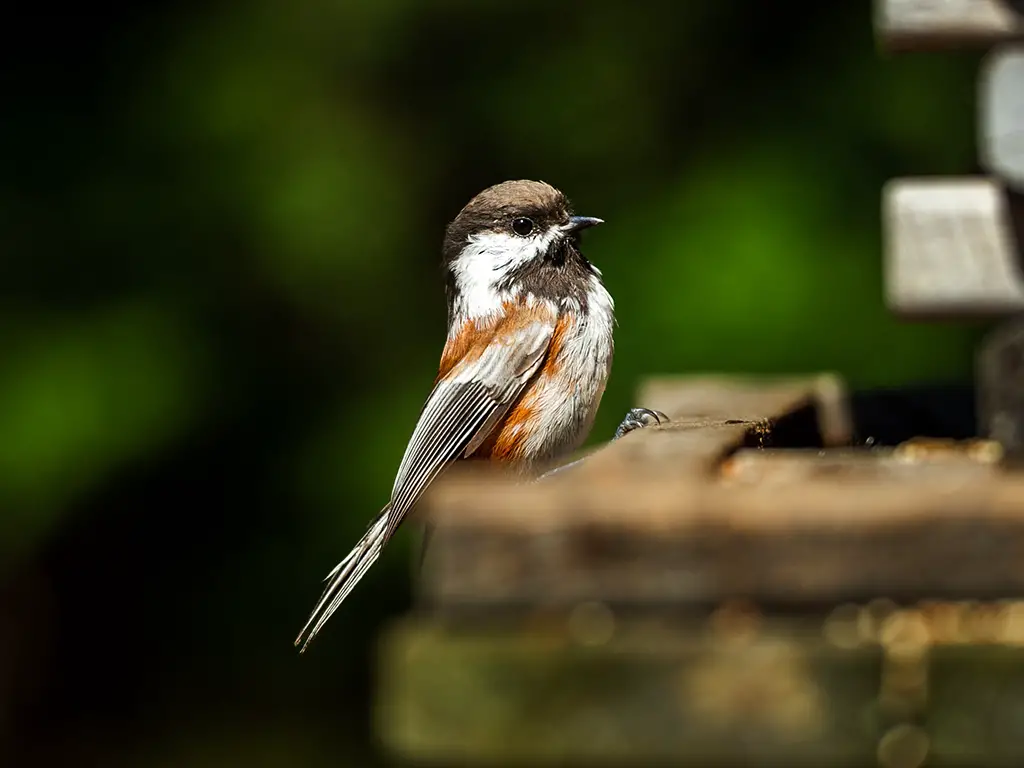
The Chestnut-backed Chickadee is a small passerine bird in the tit family, Paridae. It lives within the Pacific Northwest region of America and Canada; its range extending from southern Alaska to southwestern California.
This species remains a permanent resident throughout its area rather than migrating seasonally, although feeding flocks may temporarily move short distances for food sources.
They are commonly found in woodlands with dense understory vegetation as well as suburban gardens.
The male and female birds can be distinguished by their distinctive patterned plumage: males have brown backs while females are grayer above but both share white bellies and buffy sides striped with black barring across their wings and tails.
These sociable birds usually feed on insects or seeds which they obtain from trees or shrubs using their sharp beaks.
Scientific classification:
| Kingdom | Animalia |
| Phylum | Chordata |
| Class | Aves |
| Order | Passeriformes |
| Family | Paridae |
| Genus | Poecile |
| Species | P. rufescens |
Also Featured In: Chickadees Birds, Birds That Live around Seattle
14. Oak Titmouse
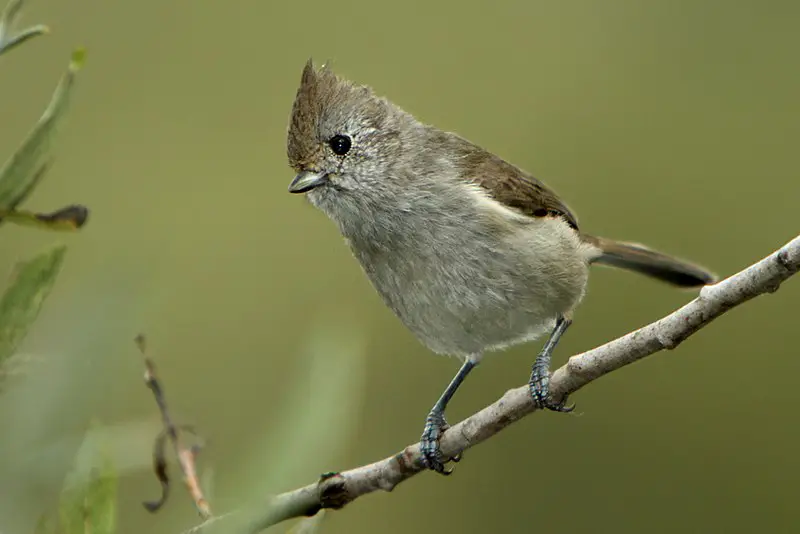
The Oak Titmouse is a small passerine bird of the tit family, Paridae. It has an overall grayish-brown plumage with a cream-colored underside and its face is plain in coloration lacking any distinct patterning or markings.
The distinguishing feature of this species, however, is the tufted crest on top of its head that gives it a unique appearance.
They are native to western North America where they inhabit oak woodlands and chaparral habitats at elevations between sea level up to 5500 feet above sea level.
These birds feed mostly on insects such as caterpillars but also consume seeds and fruits during colder months when insect prey becomes scarce.
In addition, they have been seen stealing food from other birds’ nests including acorn Woodpecker’s caches.
Scientific classification:
| Kingdom | Animalia |
| Phylum | Chordata |
| Class | Aves |
| Order | Passeriformes |
| Family | Paridae |
| Genus | Baeolophus |
| Species | B. inornatus |
Also Featured In: Birds that Live in San Francisco Bay Area, Marin Birds You Should Know
15. Western Kingbird
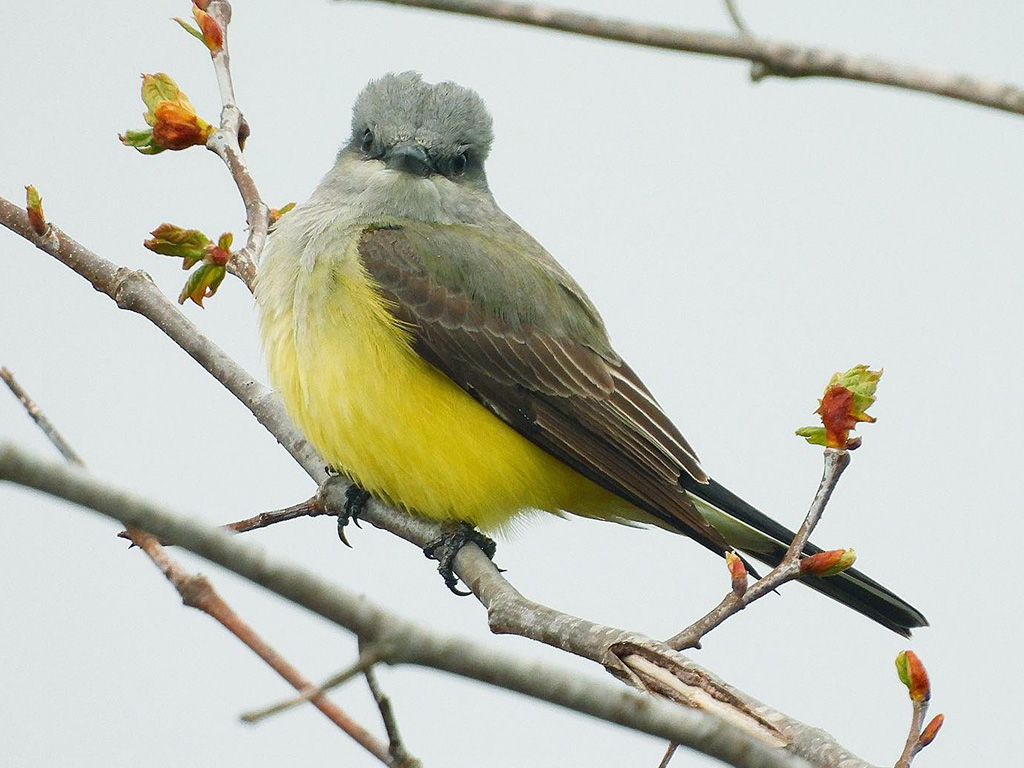
The Western kingbird is a large tyrant flycatcher native to western North America. It has striking plumage, with gray and yellow feathers tinged with crimson during courtship or when defending territory from intruders.
As is characteristic of its kind, the Western Kingbird exhibits highly territorial behavior towards other birds in its area.
They are found as far south as Mexico, inhabiting open habitats near bodies of water such as rivers and lakes.
While their primary diet consists of insects like bees and flies that they catch mid-flight, it also includes fruit for variety during winter months.
The species have recently seen an increase in population due to conservation efforts that aim to protect these beautiful creatures.
Scientific classification:
| Kingdom | Animalia |
| Phylum | Chordata |
| Class | Aves |
| Order | Passeriformes |
| Family | Tyrannidae |
| Genus | Tyrannus |
| Species | T. verticalis |
Also Featured In: Flycatchers Species, Birds that Live in the Deserts
16. Black Phoebe
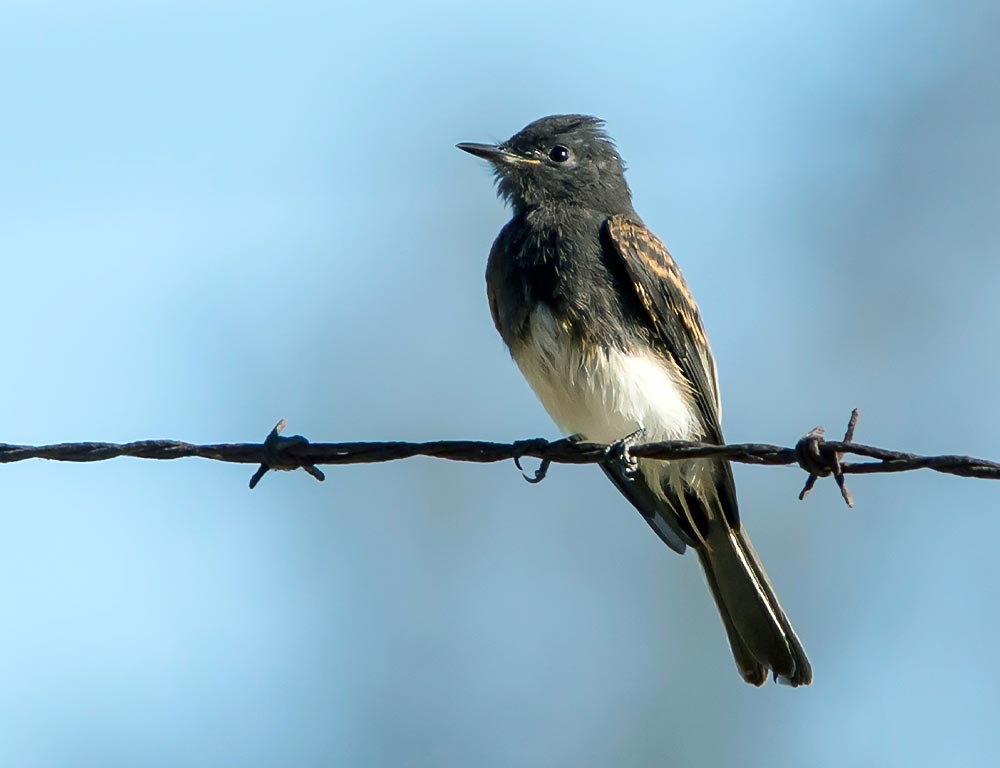
The black phoebe is a beautiful passerine bird belonging to the tyrant flycatcher family. It breeds from southwest Oregon and California south through Central and South America, where it can be found year-round.
However, its northern populations tend to migrate seasonally in some areas. Six subspecies of this species have been identified so far: two are occasional visitors while the others are more common residents in their range.
The adult has mainly dark grey upperparts with a white belly; juveniles may show brownish tones instead of grey ones on their back.
Its main diet consists of insects which it catches by hovering over water or flying out after them from perches near rivers or streams – hence why they’re often seen around these places.
Scientific classification:
| Kingdom | Animalia |
| Phylum | Chordata |
| Class | Aves |
| Order | Passeriformes |
| Family | Tyrannidae |
| Genus | Sayornis |
| Species | S. nigricans |
Also Featured In: Birds Live Near San Diego, Birds Commonly Found in Northern California
17. Ring-Billed Gull
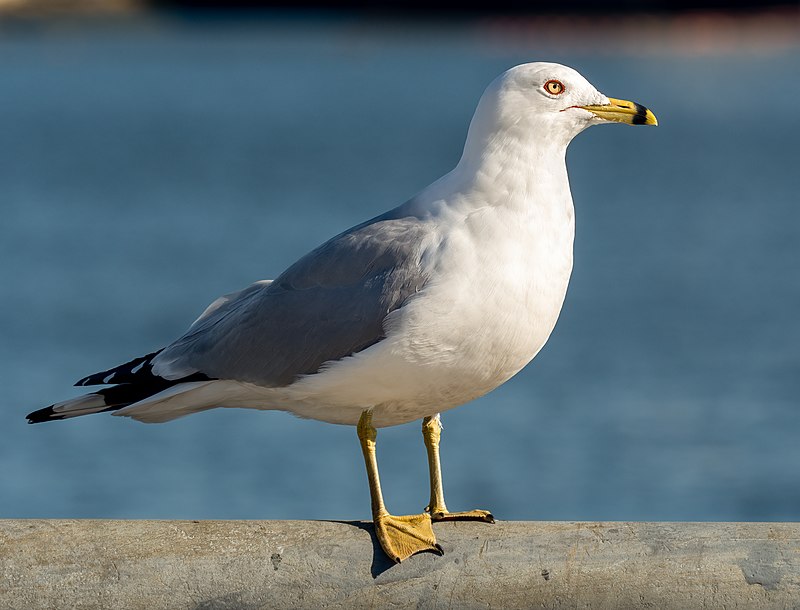
The Ring-billed Gull is a medium-sized seabird that can be seen throughout North America. Its head, neck, and underparts are white while its back and wings are silver-gray.
It has a relatively short yellow bill with a dark ring around it, as well as yellow legs.
The genus name for this species of gull comes from the Latin word ‘Larus’ which refers to large sea birds or gulls; while the specific delawarensis refers to the Delaware River where these birds were first discovered.
These beautiful creatures thrive near coasts, lakeshores, and other bodies of water but also have been known to inhabit urban areas such as parks close by those watersides due to their adaptability towards human habitats.
Scientific classification:
| Kingdom | Animalia |
| Phylum | Chordata |
| Class | Aves |
| Order | Charadriiformes |
| Family | Laridae |
| Genus | Larus |
| Species | L. delawarensis |
Also Featured In: Gulls Species, Most Common Lake Birds
18. Western Gull
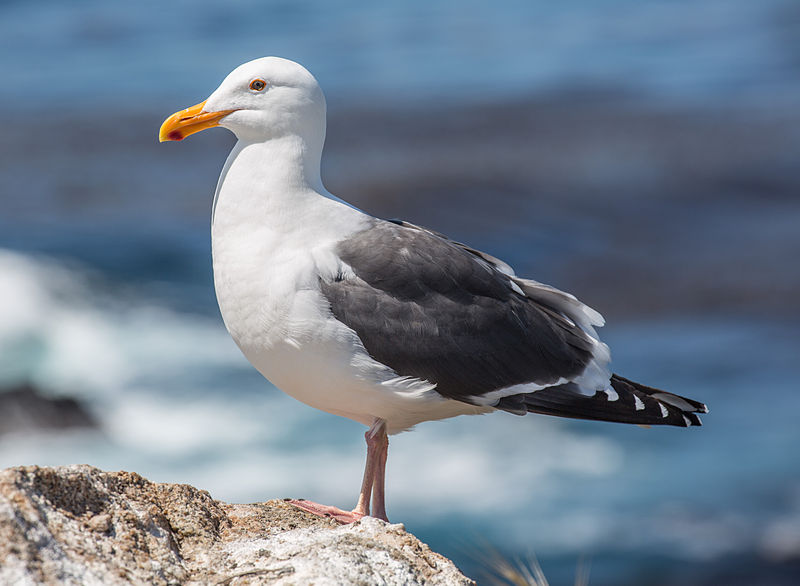
The Western Gull is a majestic seabird found on the West Coast of North America, ranging from British Columbia to Baja California. It has a large white head and stands between 22-27 inches in size.
Its upper parts are gray while its underparts range from brownish-grey to white depending on the age or sex of the bird.
The most distinguishing feature is its yellow feet which set it apart from other gulls in the area such as Larus livens.
These birds feed by scavenging for food including fish, mollusks, crustaceans, and even carrion when available.
They also nest near ocean shores with their eggs hatching anywhere within 28 days after being laid. A beautiful sight to behold at any beach; these birds will surely captivate you with their grandeur.
Scientific classification:
| Kingdom | Animalia |
| Phylum | Chordata |
| Class | Aves |
| Order | Charadriiformes |
| Family | Laridae |
| Genus | Larus |
| Species | L. occidentalis |
Also Featured In: Birds that Live in the Ocean , Birds of Oregon Coast
19. Franklin’s Gull
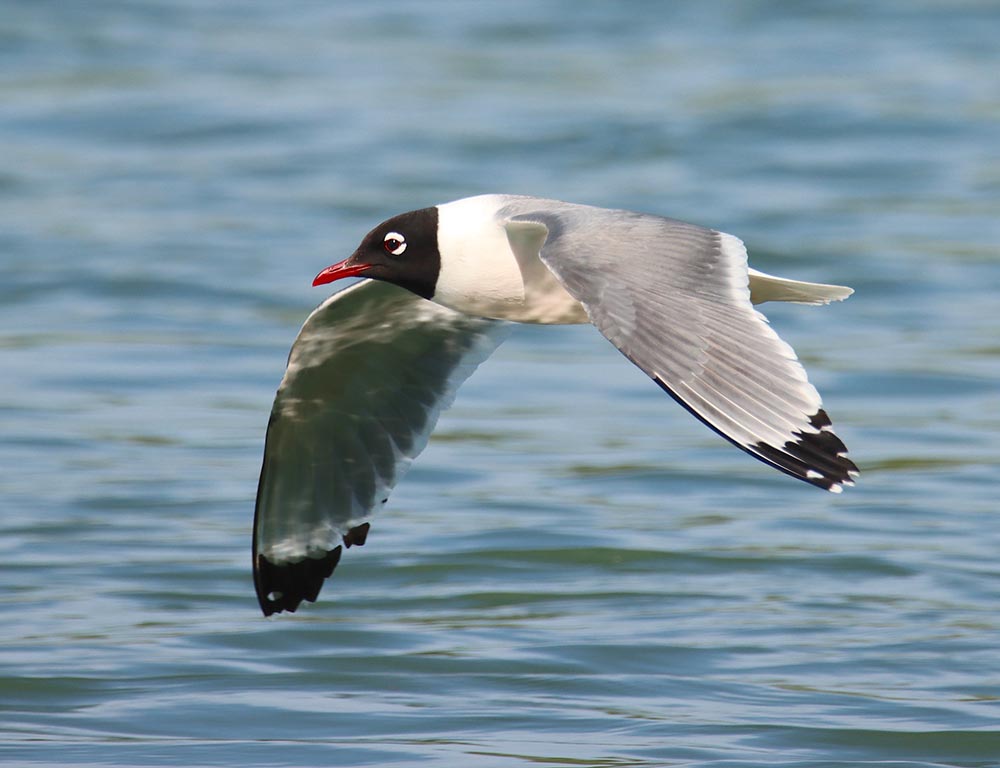
Franklin’s gull is a small species of seagull that breeds in the central provinces of Canada and certain states in the north of the United States. During winter, they migrate to Argentina, the Caribbean islands, and other parts further south.
The Franklin’s Gull has an average length between 32-36 cm with white head plumage and darker grey wings.
Its genus name Leucophaeus derives from the Ancient Greek leukos meaning ‘white’ and phaios for ‘dusky’ while its specific pipixcan comes from a Nahuatl word for ‘gull’.
In addition to their striking appearance, these birds are also known for their distinct call which sounds like laughing or crying.
Scientific classification:
| Kingdom | Animalia |
| Phylum | Chordata |
| Class | Aves |
| Order | Charadriiformes |
| Family | Laridae |
| Genus | Leucophaeus |
| Species | L. pipixcan |
Also Featured In: Wetlands Birds You Should Know, White Birds Commonly Found in Hawaii
20. Northern Saw-Whet Owl
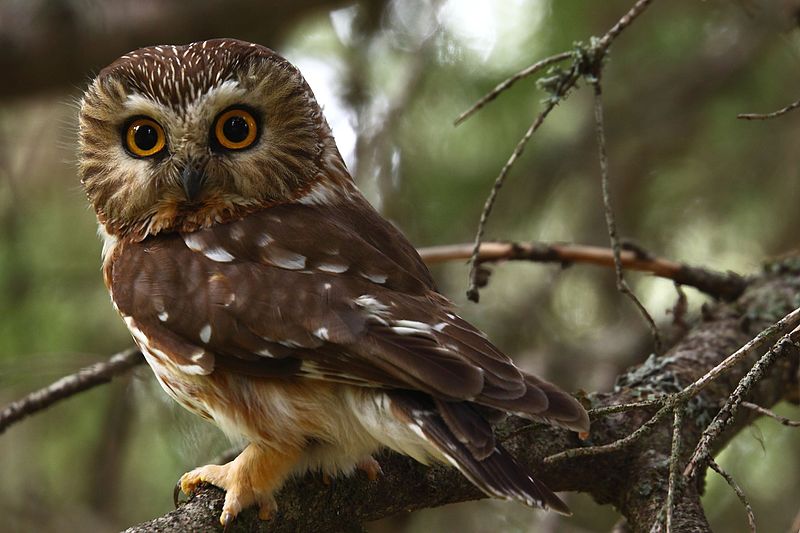
The Northern saw-whet owl is a small species of bird native to North America. It can be found in dense thickets, either at eye level or up to 20 feet high.
These owls are among the smallest species of their kind on the continent and have sharp claws for hunting prey such as rodents and other birds.
Due to its size, it often falls victim to predators like larger hawks and eagles which hunt them down relentlessly.
Fortunately, they camouflage well with their brown feathers that blend into trees easily giving them some protection from these hunters while they search for food during nighttime hours when most predators are asleep.
Scientific classification:
| Kingdom | Animalia |
| Phylum | Chordata |
| Class | Aves |
| Order | Strigiformes |
| Family | Strigidae |
| Genus | Aegolius |
| Species | A. acadicus |
Also Featured In: Owls Species, Birds that Found in the Yellowstone
21. White-Crowned Sparrow
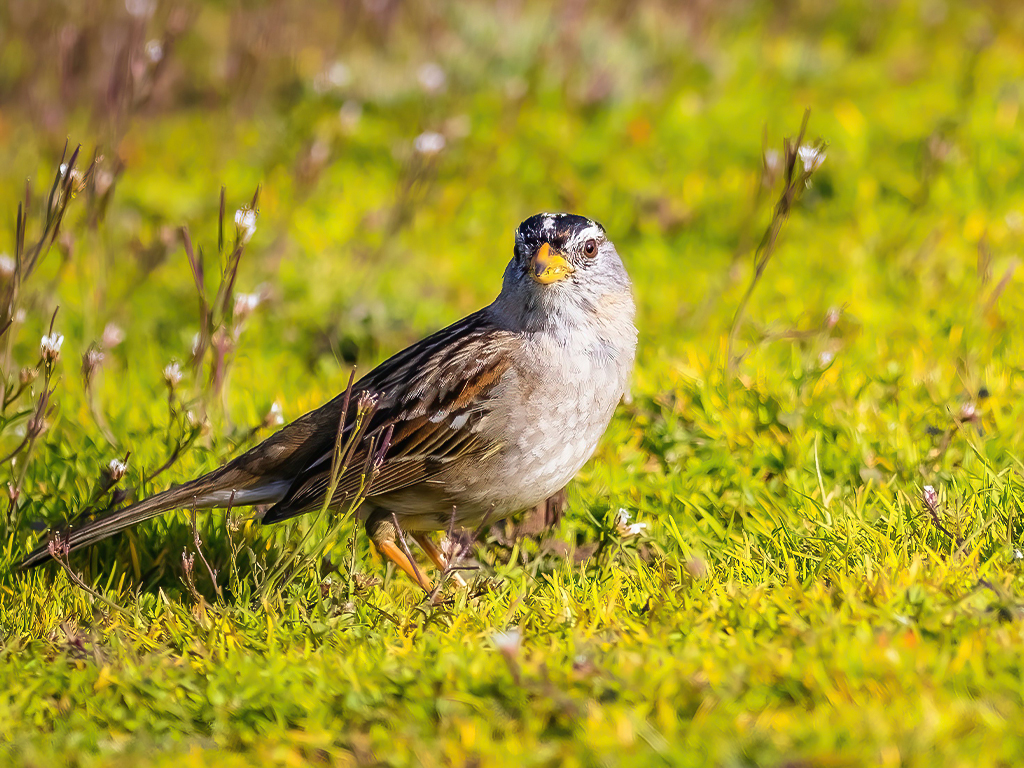
The White-crowned Sparrow is a species of passerine bird native to North America. It has a grey face and black and white streaking on its upper head, making it easy to identify.
This sparrow usually breeds in brushy areas located in the taiga, tundra, Rocky Mountains or Pacific coast regions of North America.
During winter months these birds migrate southward as far as Mexico and California where they can be found living amongst chaparral shrubbery or low bushes near open fields with plenty of seeds nearby.
The diet of this bird consists mainly of insects during summer while they switch over to eating grains like wheat & oats during colder months when bugs are scarce.
They are known for their characteristic chirp which sounds like “Oh sweet Canada Canada” drawing admirers from around the world.
Scientific classification:
| Kingdom | Animalia |
| Phylum | Chordata |
| Class | Aves |
| Order | Passeriformes |
| Family | Passerellidae |
| Genus | Zonotrichia |
| Species | Z. leucophrys |
Also Featured In: Sparrows Species, Most Common Songs Birds that Live around You
22. Western Bluebird
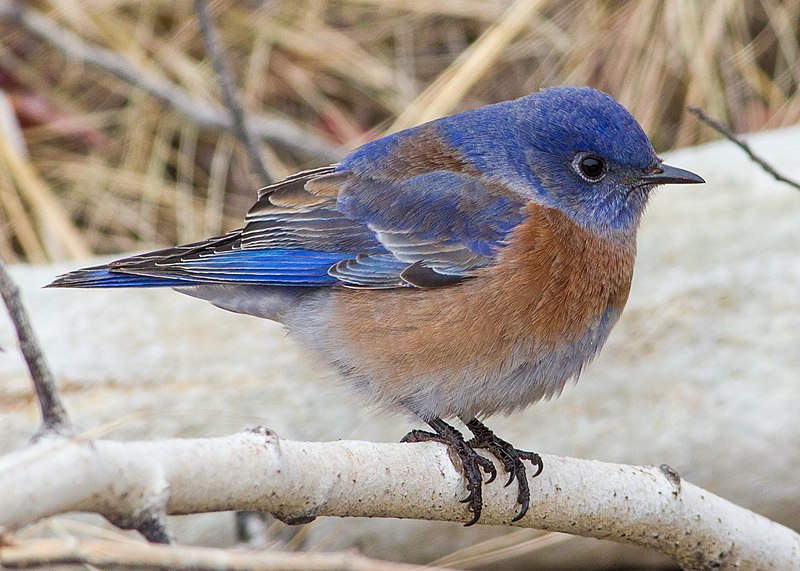
The Western Bluebird is a small North American thrush that was formally described by English naturalist William John Swainson in 1832.
It has six subspecies and measures 15 to 18 cm long, with the adult male being bright blue on top and light orange-brown underneath.
Its wings have white bars which contrast against its bright plumage. The female is duller overall but retains the same wing pattern as its counterpart.
In addition, it also sports an attractive reddish patch near its bill area when breeding season arrives.
This species can be found inhabiting open woodlands, grassy meadows, or agricultural areas of western America from Alaska southwards into Mexico and Guatemala where they feed mainly on insects such as beetles, flies, ants, etc.
All in all this gorgeous bird adds colour to any environment.
Scientific classification:
| Kingdom | Animalia |
| Phylum | Chordata |
| Class | Aves |
| Order | Passeriformes |
| Family | Turdidae |
| Genus | Sialia |
| Species | S. mexicana |
Also Featured In: Thrush Species, Blue Birds You’ll Found around Us
23. California Scrub Jay
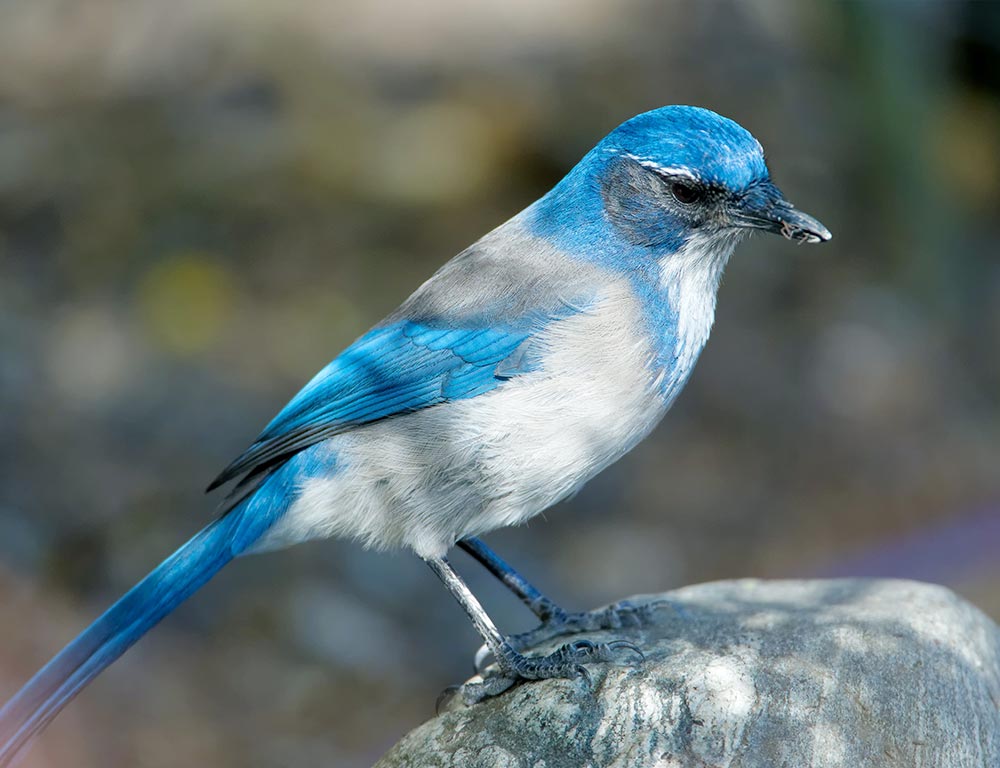
The California scrub jay is a species of bird native to western North America. It can be found from southern British Columbia down through California and western Nevada near Reno, up to the west beyond the Sierra Nevada range.
This beautiful blue feathered bird was once categorized with Woodhouse’s scrub jay as the “western scrub jay” along with island scrub jays.
The California Scrub Jay has distinctive features such as its greyish-blue feathers on its head, wings, and tail; white cheeks; dark bill; and strong legs for perching in trees which makes it stand out among other birds in its family.
Scientific classification:
| Kingdom | Animalia |
| Phylum | Chordata |
| Class | Aves |
| Order | Passeriformes |
| Family | Corvidae |
| Genus | Aphelocoma |
| Species | A. californica |
Also Featured In: Common Californian Birds, Summer Birds that Live around Us
24. California Towhee
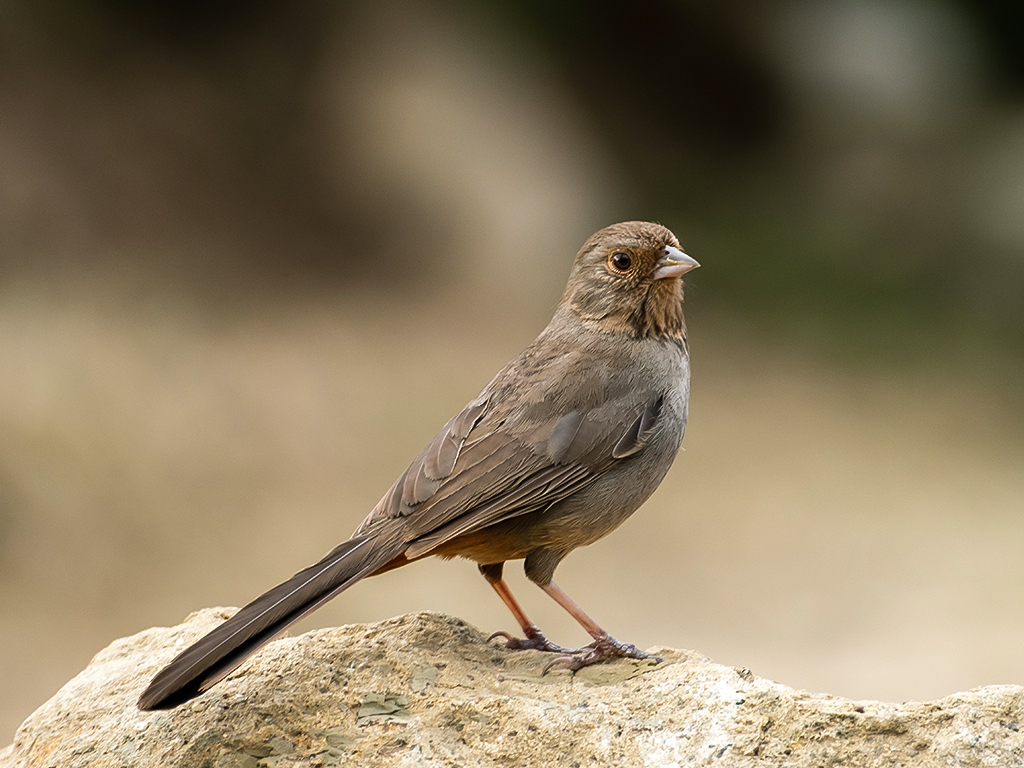
The California towhee (Melozone crissalis) is a medium-sized bird belonging to the family Passerellidae.
It can be found in the coastal regions of Oregon, California, and Baja California Sur in Mexico.
This species has been subject to taxonomic debate – some authors place it within Fringillidae instead.
The male Californian towhee is easily identified by its greyish-brown plumage with black streaks on its back, tail, and wings; while females have duller colors than males but still retain the same patterned feathering as them.
Additionally, they possess an orange-colored bill and legs which adds a pop of color to their otherwise dusky appearance.
Scientific classification:
| Kingdom | Animalia |
| Phylum | Chordata |
| Class | Aves |
| Order | Passeriformes |
| Family | Passerellidae |
| Genus | Melozone |
| Species | M. crissalis |
Also Featured In: Birds that Live in Chaparral,
25. White-Tailed Kite
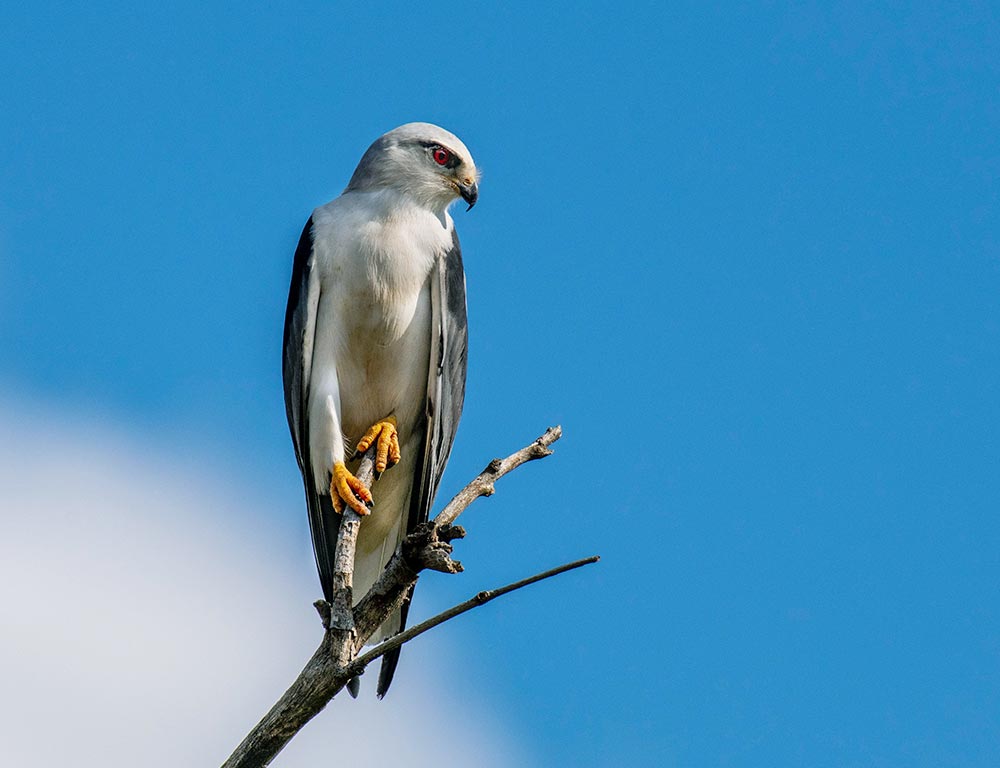
The White-tailed Kite is a small raptor found in western North America and parts of South America. It was first described by French ornithologist Louis Jean Pierre Vieillot in 1818, with the type locality being Paraguay.
This species belongs to the same family as Old World black-winged kites but is more widespread than its relative.
They are recognized easily due to their distinct white heads and tails, grey wings and backs, yellow eyes and legs.
These birds primarily hunt for rodents such as mice during daylight hours using their exceptional hunting skills like hovering midair before diving down on prey or swooping low over grasslands looking for food items on the ground.
In addition, they also feed upon insects including grasshoppers and locusts which provides them additional nutrition throughout the summer months.
Scientific classification:
| Kingdom | Animalia |
| Phylum | Chordata |
| Class | Aves |
| Order | Accipitriformes |
| Family | Accipitridae |
| Genus | Elanus |
| Species | E. leucurus |
Also Featured In: Everglades Birds, Black And White Birds You Don’t Know About
26. California Thrasher
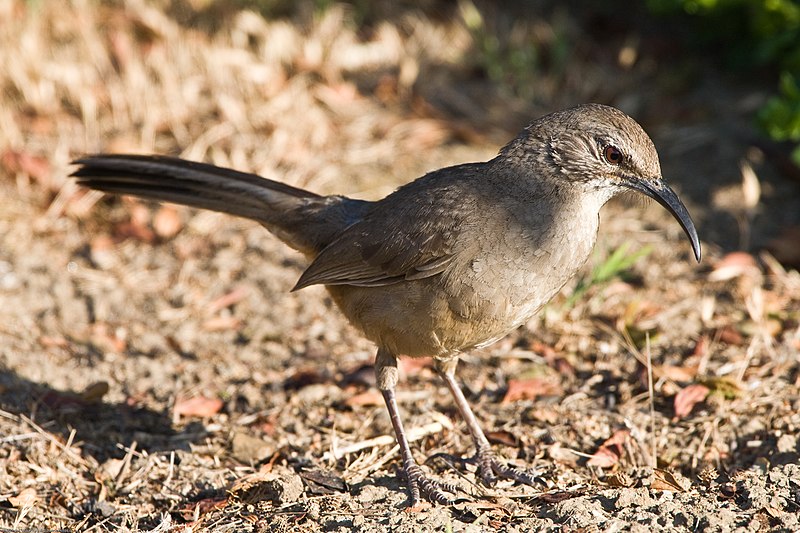
The California thrasher is a member of the Mimidae family and is found in chaparral habitats in both California and Baja California. It has grey-brown upperparts, white underparts with pale streaks, yellow eyes, and a black bill.
Its long tail helps it to forage through dense vegetation as well as aiding its agility when climbing trees or shrubs.
The species’ diet consists mainly of insects such as beetles, ants, and grasshoppers but can also feed on small fruits like berries or seeds from wildflowers.
It builds an open cup nest out of twigs, stems, and leaves which are lined with soft material like feathers or fur near the base of bushes or low tree branches.
This bird forms part of a superspecies along with the crissal thrasher (Toxostoma crissale) and LeConte’s thrasher (Toxostoma lecontei).
Scientific classification:
| Kingdom | Animalia |
| Phylum | Chordata |
| Class | Aves |
| Order | Passeriformes |
| Family | Mimidae |
| Genus | Toxostoma |
| Species | T. redivivum |
27. Sharp-Shinned Hawk
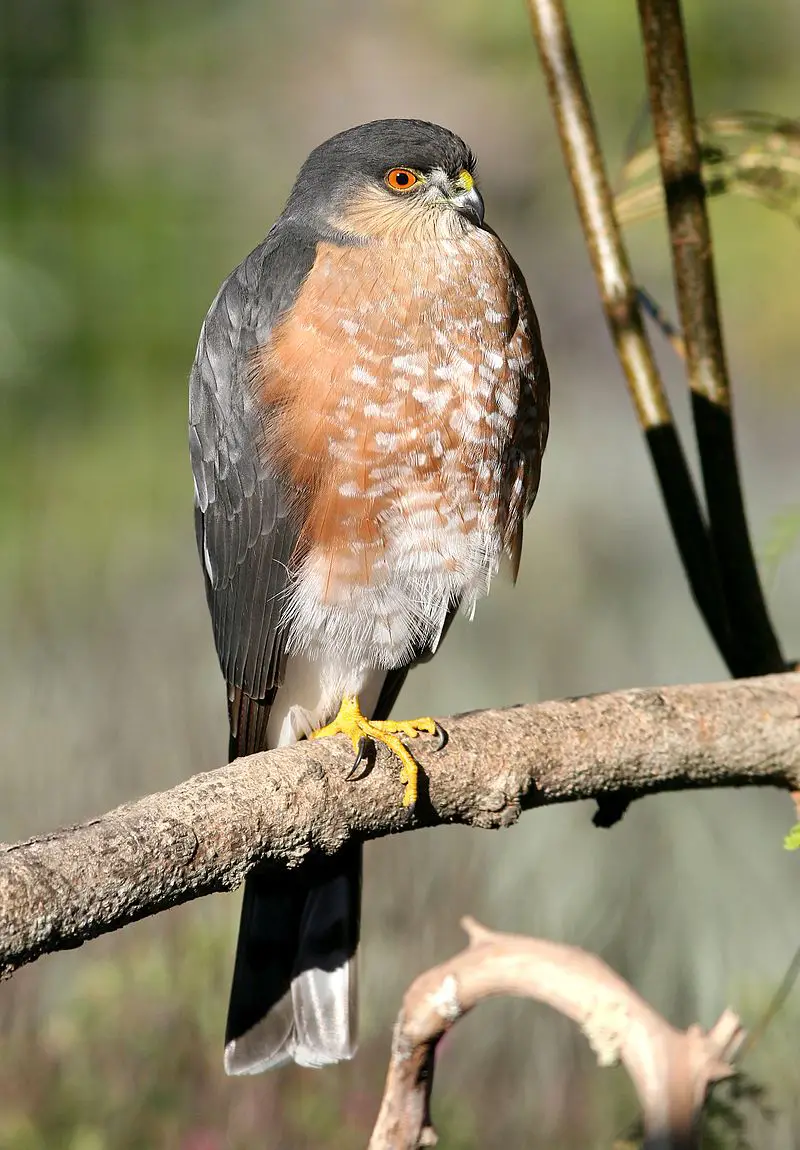
The Sharp-shinned Hawk is a small hawk found throughout the United States and Canada. It is one of the smallest hawks in North America, but larger than some Neotropical species such as the tiny hawk.
The taxonomy of this bird remains uncertain; with some authorities suggesting that southern taxa may represent three distinct species: white-breasted hawk (A. chionogaster), plain-breasted hawk (A. ventralis) and rufous morph sharp-shinnedhawk(A. rufiventris).
These birds feed primarily on small birds like finches, sparrows, woodpeckers, and warblers while hunting from perches or by flying through dense vegetation to surprise unsuspecting prey items.
They are agile flyers that rely heavily on surprise to capture their food items quickly before they can fly away.
Scientific classification:
| Kingdom | Animalia |
| Phylum | Chordata |
| Class | Aves |
| Order | Accipitriformes |
| Family | Accipitridae |
| Genus | Accipiter |
| Species | A. striatus |
Also Featured In: Utah Birds, New Hampshire Birds You Should Know
28. Brown Pelican
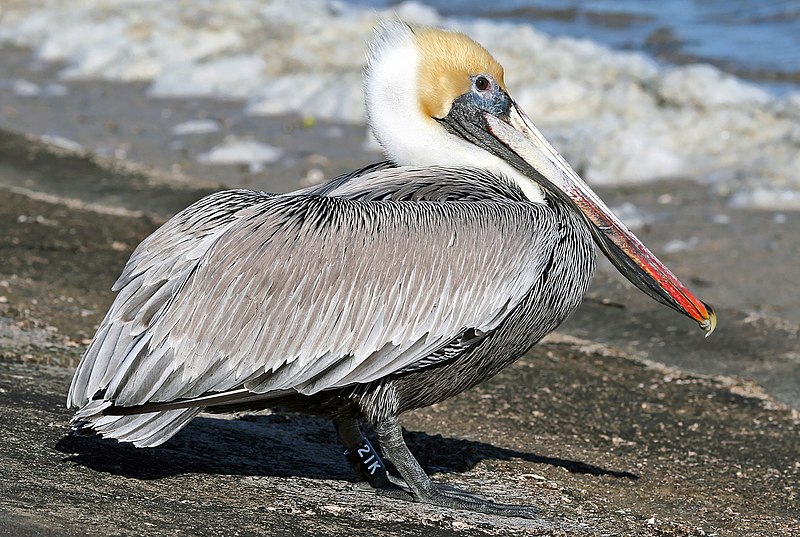
The majestic brown pelican is a dive-feeding bird that belongs to the pelican family. It is one of the three pelican species found in the Americas and is known to dive into water to catch its prey.
From the Atlantic Coast of New Jersey to the mouth of the Amazon River, and along the Pacific Coast from British Columbia to northern Chile, including the Galapagos Islands, this bird can be found.
Its scientific name is Pelecanus occidentalis, and it has a colored brown plumage, which is its distinct characteristic.
The brown pelican belongs to the largest bird species that exists today, with a wingspan that can stretch up to seven feet long.
This bird helps maintain a balance in the ecosystem by eating smaller fish, crustaceans, and other aquatic prey.
Scientific classification:
| Kingdom | Animalia |
| Phylum | Chordata |
| Class | Aves |
| Order | Pelecaniformes |
| Family | Pelecanidae |
| Genus | Pelecanus |
| Species | P. occidentalis |
Also Featured In: Birds You’ll Find in the Sea, Water Birds Live around Us
29. Red-Shouldered Hawk
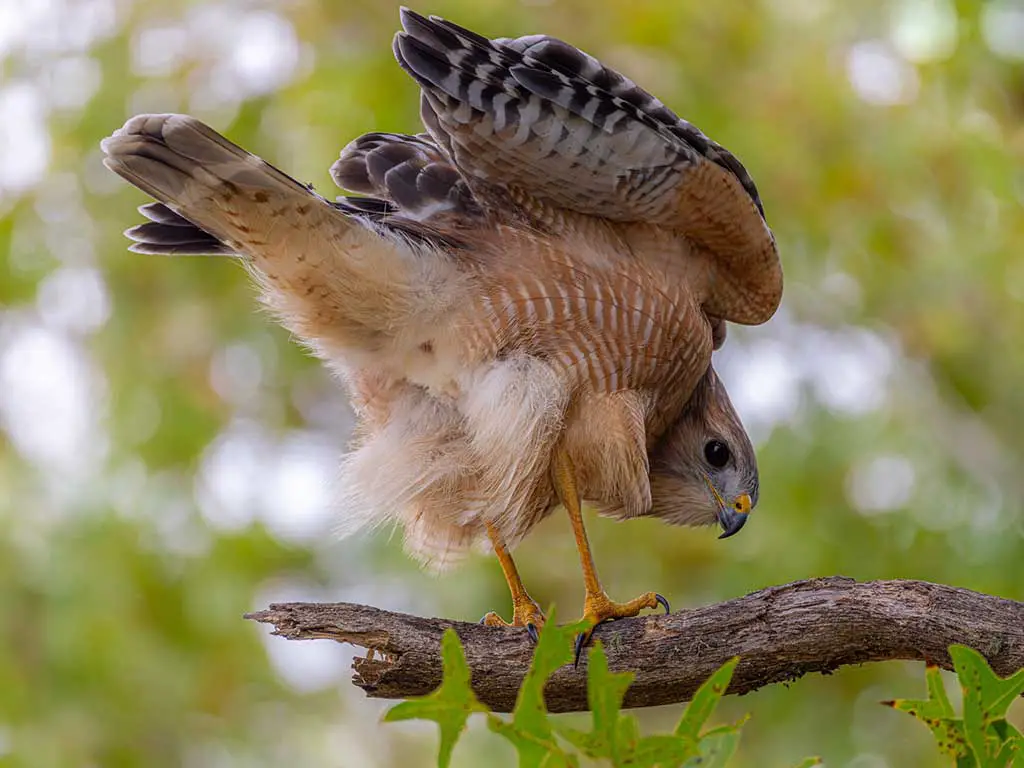
The red-shouldered hawk, also known as Buteo lineatus, is a medium-sized bird of prey found in eastern North America and along the coast of California and northern to northeastern-central Mexico.
While many of these hawks are permanent residents within their range, northern populations do migrate, with most traveling to central Mexico.
The species faces numerous threats to its survival, with deforestation being a primary issue.
Despite the many challenges they face, these birds are an important part of their ecosystems, primarily feeding on rodents, small mammals, and amphibians.
In addition to their hunting capabilities, these hawks are known for their striking appearance, featuring reddish brown shoulder feathers and bold black and white striped wings.
Overall, the red-shouldered hawk is a fascinating and important bird that plays a vital role in its surroundings.
Scientific classification:
| Kingdom | Animalia |
| Phylum | Chordata |
| Class | Aves |
| Order | Accipitriformes |
| Family | Accipitridae |
| Genus | Buteo |
| Species | B. lineatus |
Also Featured In: Birds Commonly Found in New York, Birds Live in Arkansas
To Recap
Southern California’s wildlife is a testament to the rich biodiversity and natural beauty that can be found in this region.
The 29 birds highlighted in this collection represent just a fraction of the incredible avian diversity that graces the skies and landscapes of Southern California.
From the vibrant Western Tanager to the majestic California Condor, each species adds a unique layer to the tapestry of this unique ecosystem.
These birds not only captivate with their colors and forms but also play vital roles in maintaining the ecological balance of the region.
Protecting their habitats and conserving these species is essential to preserving the natural heritage of Southern California for generations to come.